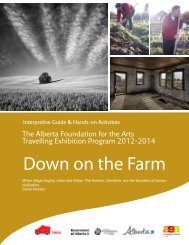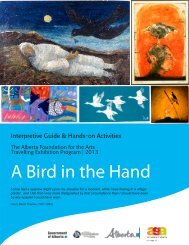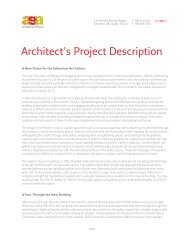Optical Illusions - Art Gallery of Alberta
Optical Illusions - Art Gallery of Alberta
Optical Illusions - Art Gallery of Alberta
- No tags were found...
Create successful ePaper yourself
Turn your PDF publications into a flip-book with our unique Google optimized e-Paper software.
2 Sir Winston Churchill SquareEdmonton, AB, Canada T5J 2C1T: 780.422.6223F: 780.426.3105youraga.ca<strong>Optical</strong> <strong>Illusions</strong>Grades 3-12Students explore the work <strong>of</strong> M.C. Escher in the gallery spaces focusing on Escher’s use <strong>of</strong> patterns, mathematics andprintmaking before returning to the studio to create their own 2-D composition inspired by the work <strong>of</strong> Escher. In thestudio students explore <strong>Optical</strong> art, illusions and printmaking in preparation for creating a printing block that is used tocreate a tessellated composition.Main Objectives• Students investigate optical art and how artists use illusion in artwork to play with space and perception• Students explore the work <strong>of</strong> M.C. Escher to discover how patterns and relief printmaking can be used to create 2-Dcompositions• Students employ and arrange the elements and principles to create a tessellated pattern that forms a unique 2-Dcomposition• Students experiment with relief printmakingConnections to <strong>Alberta</strong> Education Programs <strong>of</strong> StudyFine <strong>Art</strong>s - Elementary <strong>Art</strong> ProgramMEDIA EXPLORATION: students will experiment with relief printmaking and tessellations.DEPICTION• MAIN FORMS AND PROPORTIONS:A. Shapes can suggest movement or stabilityB. Many shapes are symmetrical• ACTIONS AND VIEWPOINTS:A. Looking at negative shapes helps create a different view <strong>of</strong> something• QUALITIES AND DETAILS:A. Texture can be represented from a range <strong>of</strong> different studio techniquesCOMPOSITION• UNITY: students will create unity by interrelating the parts <strong>of</strong> a compositionA. The parts can be arranged so that movement in the picture space leads the eye around and not out <strong>of</strong> the pictureareaC. Every major area <strong>of</strong> a composition should be interesting in itselfD. Limited colours and materials tighten a composition
2 Sir Winston Churchill SquareEdmonton, AB, Canada T5J 2C1T: 780.422.6223F: 780.426.3105youraga.caFine <strong>Art</strong>s - Grade 7-12 <strong>Art</strong> ProgramCOMPOSITIONS• Components: STUDENTS WILL BECOME FAMILIAR WITH THE COMPONENTS OF IMAGES, MEDIA TECHNIQUESAND DESIGN ELEMENTS.• Relationships: STUDENTS WILL ANALYZE THE RELATIONSHIPS AMONG COMPONENTS OF IMAGES.MathPATTERNS AND RELATIONSHIPS (PATTERNS)• Use patterns to describe the world and to solve problemsSHAPES AND SPACE (3-D OBJECTS AND 2-D SHAPES)• Describe the characteristics <strong>of</strong> 3-D objects and 2-D shapes, and analyze the relationships among themSHAPE AND SPACE (TRANSFORMATIONS)• Describe and analyze position and motion <strong>of</strong> objects and shapes.• Create patterns and designs that incorporate symmetry, tessellations, translations and reflections
















